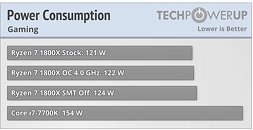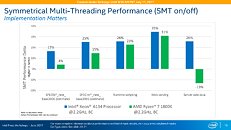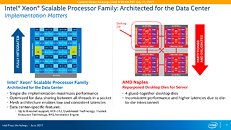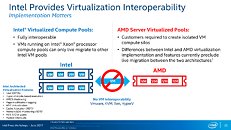Raevenlord
News Editor
- Joined
- Aug 12, 2016
- Messages
- 3,755 (1.19/day)
- Location
- Portugal
| System Name | The Ryzening |
|---|---|
| Processor | AMD Ryzen 9 5900X |
| Motherboard | MSI X570 MAG TOMAHAWK |
| Cooling | Lian Li Galahad 360mm AIO |
| Memory | 32 GB G.Skill Trident Z F4-3733 (4x 8 GB) |
| Video Card(s) | Gigabyte RTX 3070 Ti |
| Storage | Boot: Transcend MTE220S 2TB, Kintson A2000 1TB, Seagate Firewolf Pro 14 TB |
| Display(s) | Acer Nitro VG270UP (1440p 144 Hz IPS) |
| Case | Lian Li O11DX Dynamic White |
| Audio Device(s) | iFi Audio Zen DAC |
| Power Supply | Seasonic Focus+ 750 W |
| Mouse | Cooler Master Masterkeys Lite L |
| Keyboard | Cooler Master Masterkeys Lite L |
| Software | Windows 10 x64 |
So, yes, Intel, I think the AMD engineers who have developed the Zen architecture from the ground-up would take issue with that. Especially when AMD's "Glued-together" dies actually wipe the proverbial floor with the blue company's chips in power-performance ratios, and deliver much better multi-threaded performance than Intel's offerings. Not bad for a "Glued-together" solution, I'd say.
Our resident W1zzard had this to say regarding AMD's latest CPUs: "The SenseMi power-management system seems to be working well in idle, with the 8-core machine drawing the same amount of power as Intel's quad-core "Kaby Lake" machine." And "At stock speeds, the energy-efficiency of Ryzen is truly phenomenal. Prime95 loads all cores and threads on the chip, and the Ryzen ends up with as much power draw as the quad-core Intel i7-7700K. The high power draw result of the overclocked chip is due to the increased voltage needed to achieve stable operation." And let's not forget this: This is epic. We're assuming you've sifted through our game-test results before seeing this page, and so you'll find that the gaming power draw of the 8-core Ryzen makes Intel's quad-core i7-7700K look bad. Power draw is as much as 30W lesser! Ryzen is hands down the most energy-efficient performance CPU AMD ever made, and easily outclasses Intel's 14 nm "leadership." Good show."





On SMT implementation between AMD's SMT and Intel's HT, Intel is basically comparing a $2,200 8-core Xeon to AMD's usually $499 Ryzen 7 1800X. They are correct in terms of core parity there, at least, but I think it goes more against Intel's customer fleecing in core/price ratios than anything else. And it's certainly a coincidence that for Intel to achieve these SMT implementation scaling numbers, which paints them in good light, they had to down-clock the Ryzen 1800X to 2.2 GHz. So, yes. Even though independent review sites have put AMD's EPYC 7601 SMT-powered improvement in various workloads at a 24% average improvement, and Intel's Xeon 8176 falls short of that at 19.58% (even rounding AMD's score down and Intel's up, that's still how big the gap is.)

Here, Intel is comparing their server-grade processors with AMD's Ryzen, desktop processors gaming woes, which really, is one of the best examples of comparing apples to oranges that I've seen in a long time. So AMD's server platform will require optimizations as well because Ryzen did, for incomparably different workloads? History does inform the future, but not to the extent that Intel is putting it here to, certainly. Putting things in the same perspective, is Intel saying that their Xeon ecosystem sees gaming-specific optimizations?


Ah, the "Glued-together" dies. Let's forget how AMD's Zen cores actually look like they were architected from the get-go for modularity and scaling, which has allowed the company to keep die-sizes to a minimum and yields to a maximum. This means that from a same-sized wafer, AMD can make more Ryzen/EPYC processors (because yes, that's the beauty of it, they're almost interchangeable), and in all likelihood, have more of those full-fledged dies without any defects that affect yields.
This is one of the reasons why AMD is able to offer an unlocked, true 8-core, 16-thread CPU in the Ryzen 7 1700 at less than Intel's 4-core, 8-thread i7 7700K (which consumes more power) - but also because AMD is democratizing access to cores while Intel maximized profits at the consumer's cost for almost a decade. And Infinity Fabric, which AMD also has implemented in their Vega architecture and will probably be used for the company's Zen-based APUs and next-gen Navi graphics architecture, is only glue. Intel would certainly like to be so lucky, since AMD's Infinity Fabric actually delivers more bandwidth than their UPI (Ultra Path Interconnect.)

Here, Intel are telling us how much better for the customer it is to be hard-locked to Intel's ecosystem for virtualization, since "VMs running on Intel Xeon processor compute pools can only live migrate to other Intel VM Pools". It's like they're saying "just imagine the amount of work you'll have to migrate these to AMD. Better remain with us."
Update: As some users pointed out, I used Ryzen 7 1800X power consumption figures as an example, instead of EPYC (those pictures are right here now.)


However, I consider that Intel themselves opened that door when they compared their Xeon, $2,200 offering with AMD's sub $499 Ryzen 7 1800X, which isn't a server CPU (and they down-clocked it to boot, let's not forget that.) That said, for comparison and fairness purposes, I'll just leave these here, courtesy of Anandtech, comparing dual Xeon systems (E5-2699 and the new Xeon 8176) with a dual EPYC 7601 system:
Performance in POV-Ray:

And maximum power consumption on the same application:

So essentially, AMD has 8 more cores, 16 more threads, delivers 16% more performance than Intel's e5-2699 system and 32% more performance than Intel's "non glued-together" Xeon 8176. AMD's chip does all that while consuming 23% less power than the Xeon e5-2699, and 28% less than the Xeon 8176. Not too shabby. I'll take my CPUs with this kind of glue any day.
Check the full press slides in the source. There's an interesting read there, even if there are those chuckle-worthy Intel comments that look like grappling at straws when real arguments are absent. But hey, that's this editor's interpretation. I reserve myself the right to be wrong, and to be slightly emotional at these underhanded tactics. It's just plain disrespectful for a company which stands on its engineers' shoulders to deride another's with no compelling argument.
View at TechPowerUp Main Site
Our resident W1zzard had this to say regarding AMD's latest CPUs: "The SenseMi power-management system seems to be working well in idle, with the 8-core machine drawing the same amount of power as Intel's quad-core "Kaby Lake" machine." And "At stock speeds, the energy-efficiency of Ryzen is truly phenomenal. Prime95 loads all cores and threads on the chip, and the Ryzen ends up with as much power draw as the quad-core Intel i7-7700K. The high power draw result of the overclocked chip is due to the increased voltage needed to achieve stable operation." And let's not forget this: This is epic. We're assuming you've sifted through our game-test results before seeing this page, and so you'll find that the gaming power draw of the 8-core Ryzen makes Intel's quad-core i7-7700K look bad. Power draw is as much as 30W lesser! Ryzen is hands down the most energy-efficient performance CPU AMD ever made, and easily outclasses Intel's 14 nm "leadership." Good show."





On SMT implementation between AMD's SMT and Intel's HT, Intel is basically comparing a $2,200 8-core Xeon to AMD's usually $499 Ryzen 7 1800X. They are correct in terms of core parity there, at least, but I think it goes more against Intel's customer fleecing in core/price ratios than anything else. And it's certainly a coincidence that for Intel to achieve these SMT implementation scaling numbers, which paints them in good light, they had to down-clock the Ryzen 1800X to 2.2 GHz. So, yes. Even though independent review sites have put AMD's EPYC 7601 SMT-powered improvement in various workloads at a 24% average improvement, and Intel's Xeon 8176 falls short of that at 19.58% (even rounding AMD's score down and Intel's up, that's still how big the gap is.)

Here, Intel is comparing their server-grade processors with AMD's Ryzen, desktop processors gaming woes, which really, is one of the best examples of comparing apples to oranges that I've seen in a long time. So AMD's server platform will require optimizations as well because Ryzen did, for incomparably different workloads? History does inform the future, but not to the extent that Intel is putting it here to, certainly. Putting things in the same perspective, is Intel saying that their Xeon ecosystem sees gaming-specific optimizations?


Ah, the "Glued-together" dies. Let's forget how AMD's Zen cores actually look like they were architected from the get-go for modularity and scaling, which has allowed the company to keep die-sizes to a minimum and yields to a maximum. This means that from a same-sized wafer, AMD can make more Ryzen/EPYC processors (because yes, that's the beauty of it, they're almost interchangeable), and in all likelihood, have more of those full-fledged dies without any defects that affect yields.
This is one of the reasons why AMD is able to offer an unlocked, true 8-core, 16-thread CPU in the Ryzen 7 1700 at less than Intel's 4-core, 8-thread i7 7700K (which consumes more power) - but also because AMD is democratizing access to cores while Intel maximized profits at the consumer's cost for almost a decade. And Infinity Fabric, which AMD also has implemented in their Vega architecture and will probably be used for the company's Zen-based APUs and next-gen Navi graphics architecture, is only glue. Intel would certainly like to be so lucky, since AMD's Infinity Fabric actually delivers more bandwidth than their UPI (Ultra Path Interconnect.)

Here, Intel are telling us how much better for the customer it is to be hard-locked to Intel's ecosystem for virtualization, since "VMs running on Intel Xeon processor compute pools can only live migrate to other Intel VM Pools". It's like they're saying "just imagine the amount of work you'll have to migrate these to AMD. Better remain with us."
Update: As some users pointed out, I used Ryzen 7 1800X power consumption figures as an example, instead of EPYC (those pictures are right here now.)


However, I consider that Intel themselves opened that door when they compared their Xeon, $2,200 offering with AMD's sub $499 Ryzen 7 1800X, which isn't a server CPU (and they down-clocked it to boot, let's not forget that.) That said, for comparison and fairness purposes, I'll just leave these here, courtesy of Anandtech, comparing dual Xeon systems (E5-2699 and the new Xeon 8176) with a dual EPYC 7601 system:
Performance in POV-Ray:

And maximum power consumption on the same application:

So essentially, AMD has 8 more cores, 16 more threads, delivers 16% more performance than Intel's e5-2699 system and 32% more performance than Intel's "non glued-together" Xeon 8176. AMD's chip does all that while consuming 23% less power than the Xeon e5-2699, and 28% less than the Xeon 8176. Not too shabby. I'll take my CPUs with this kind of glue any day.
Check the full press slides in the source. There's an interesting read there, even if there are those chuckle-worthy Intel comments that look like grappling at straws when real arguments are absent. But hey, that's this editor's interpretation. I reserve myself the right to be wrong, and to be slightly emotional at these underhanded tactics. It's just plain disrespectful for a company which stands on its engineers' shoulders to deride another's with no compelling argument.
View at TechPowerUp Main Site
Last edited:






